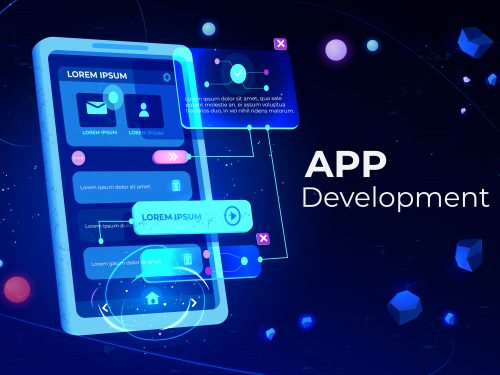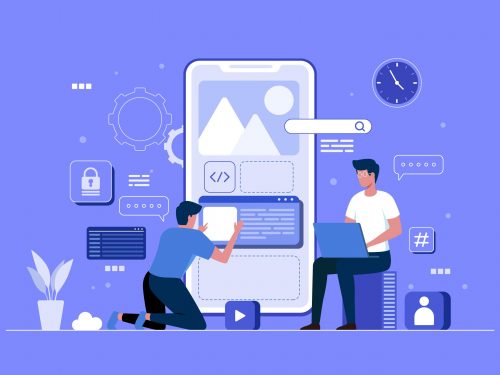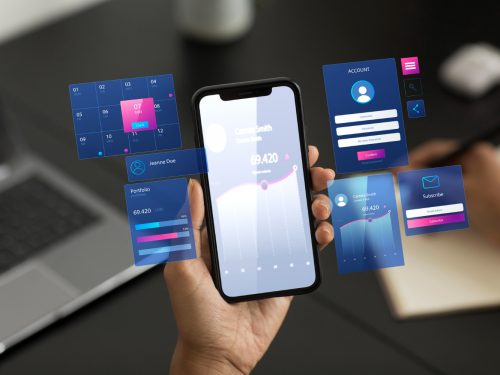The mobile app development landscape has evolved dramatically, with developers constantly seeking more efficient ways to build robust, scalable applications. Two technologies that have revolutionized this space are Flutter, Google’s cross-platform framework, and GraphQL, Facebook’s innovative query language for APIs. When combined, Flutter and GraphQL create a powerful synergy that enables developers to build highly scalable, performant mobile applications with streamlined data management.
At FBIP, a leading website designing and development company in Udaipur, we’ve witnessed firsthand how this powerful combination transforms app development workflows. As Flutter development specialists, we understand the critical importance of choosing the right data management solution for scalable applications. This comprehensive guide will walk you through everything you need to know about integrating GraphQL with Flutter to create applications that can handle massive user bases and complex data requirements.
Understanding the Power of Flutter and GraphQL Integration
Flutter has gained tremendous popularity among developers for its ability to create beautiful, native-compiled applications from a single codebase. However, as applications grow in complexity and scale, managing data efficiently becomes increasingly challenging. Traditional REST APIs often lead to over-fetching or under-fetching of data, multiple network requests, and complex state management scenarios.
GraphQL addresses these challenges by providing a flexible, efficient way to fetch exactly the data you need in a single request. When integrated with Flutter, it creates an ecosystem where developers can build highly responsive applications with optimal performance characteristics.
The benefits of combining Flutter with GraphQL extend beyond simple data fetching. This integration enables real-time data synchronization, efficient caching mechanisms, optimistic UI updates, and sophisticated error handling – all crucial components for scalable application architecture.
Why GraphQL is Perfect for Flutter Applications
GraphQL’s declarative nature aligns perfectly with Flutter’s widget-based architecture. Both technologies emphasize composability and reusability, making them natural partners in modern app development. GraphQL allows Flutter developers to specify exactly what data components need, eliminating the complexity of managing multiple REST endpoints and reducing bandwidth usage significantly.
The single endpoint approach of GraphQL simplifies Flutter app architecture by consolidating all data operations through one interface. This approach reduces the complexity of network layer management and makes it easier to implement features like offline support, caching, and real-time updates.
Furthermore, GraphQL’s type system provides excellent developer experience when working with Flutter’s Dart language. The strongly-typed nature of both technologies ensures better code reliability, improved IDE support, and more predictable runtime behavior.
Setting Up GraphQL in Your Flutter Project
Getting started with GraphQL in Flutter begins with adding the necessary dependencies to your project. The graphql_flutter package is the most popular and feature-rich GraphQL client for Flutter applications. This package provides comprehensive support for queries, mutations, subscriptions, caching, and error handling.
To add GraphQL support to your Flutter project, include the following dependency in your pubspec.yaml file:
dependencies:
graphql_flutter: ^5.1.2
After adding the dependency, you’ll need to configure the GraphQL client in your application. This involves setting up the HTTP link to your GraphQL endpoint, configuring caching policies, and establishing authentication mechanisms if required.
The configuration process typically involves creating a GraphQLClient instance with appropriate policies for caching, error handling, and network behavior. This client serves as the central point for all GraphQL operations in your application.
Implementing GraphQL Client Configuration
Proper client configuration is crucial for optimal performance and scalability. The GraphQL client configuration should include cache policies, link configuration, and error handling strategies. A well-configured client ensures efficient data management and provides a smooth user experience.
The cache configuration is particularly important for scalable applications. GraphQL’s normalized caching can significantly reduce network requests and improve application responsiveness. The cache-first policy is often ideal for data that doesn’t change frequently, while network-first policies work better for dynamic content.
Authentication configuration is another critical aspect of client setup. Many applications require user authentication, and the GraphQL client must handle token management, automatic token refresh, and secure transmission of credentials.
Writing GraphQL Queries in Flutter
GraphQL queries in Flutter are typically written as string literals or imported from separate files. For better maintainability and type safety, many developers prefer using code generation tools that create type-safe Dart classes from GraphQL schemas.
Query organization becomes increasingly important as applications scale. Grouping related queries, implementing query fragments for reusable data structures, and maintaining consistent naming conventions contribute to better code maintainability.
The Query widget provided by the graphql_flutter package makes it easy to integrate GraphQL queries with Flutter’s widget tree. This widget handles loading states, error conditions, and data rendering in a declarative manner that fits naturally with Flutter’s development paradigm.
Handling Mutations and Data Updates
Mutations in GraphQL represent data modifications – creating, updating, or deleting data. In Flutter applications, mutations are often triggered by user interactions like form submissions, button presses, or gesture events.
The graphql_flutter package provides the Mutation widget for handling data modifications. This widget offers features like optimistic updates, where the UI is updated immediately before the server confirms the change, providing a more responsive user experience.
Error handling for mutations requires careful consideration of both network errors and business logic errors returned by the GraphQL server. Implementing proper error handling ensures that users receive appropriate feedback and that the application maintains data consistency.
Implementing Real-time Data with GraphQL Subscriptions
GraphQL subscriptions enable real-time data updates in Flutter applications. This feature is particularly valuable for chat applications, live dashboards, collaborative tools, and any application requiring real-time data synchronization.
Subscriptions in Flutter are implemented using WebSocket connections or Server-Sent Events. The graphql_flutter package provides built-in support for subscriptions, handling connection management, reconnection logic, and data streaming automatically.
Proper subscription management is crucial for application performance and battery life. Implementing connection lifecycle management, handling network interruptions, and cleaning up unused subscriptions prevents memory leaks and excessive resource consumption.
Optimizing Performance and Caching
Performance optimization is critical for scalable Flutter applications using GraphQL. The combination of intelligent caching, query optimization, and efficient data fetching strategies can dramatically improve application responsiveness and reduce server load.
GraphQL’s normalized cache stores data in a flat structure, enabling efficient updates and queries. When properly configured, this cache can serve data for multiple components without additional network requests, significantly improving performance.
Query batching and query deduplication are advanced optimization techniques that can further improve performance. These strategies reduce the number of network requests and prevent duplicate data fetching when multiple components request the same data simultaneously.
Building Scalable Architecture Patterns
Scalable Flutter applications require well-designed architecture patterns that can handle growth in both features and user base. The integration of GraphQL enables several powerful architectural patterns that promote code reusability and maintainability.
The Repository pattern works particularly well with GraphQL in Flutter applications. This pattern abstracts data access logic, making it easier to implement features like offline support, data synchronization, and caching strategies. The repository layer can intelligently decide whether to fetch data from the cache, network, or local storage.
State management becomes more straightforward with GraphQL’s reactive nature. Popular state management solutions like Provider, Riverpod, or BLoC integrate seamlessly with GraphQL queries and mutations, providing a clean separation of concerns and predictable data flow.
Error Handling and User Experience
Robust error handling is essential for production-ready Flutter applications. GraphQL provides detailed error information that can help developers implement sophisticated error handling strategies. The graphql_flutter package offers comprehensive error handling capabilities, including network errors, GraphQL errors, and parsing errors.
User experience considerations should include loading states, error states, and empty states. The declarative nature of GraphQL queries in Flutter makes it easy to implement these states consistently across the application.
Offline support and error recovery mechanisms are particularly important for mobile applications. Implementing retry logic, queue mechanisms for failed mutations, and intelligent cache utilization ensures that applications remain functional even with poor network connectivity.
Testing GraphQL Integration
Testing GraphQL-integrated Flutter applications requires a comprehensive strategy that covers unit tests, widget tests, and integration tests. The graphql_flutter package provides testing utilities that make it easier to mock GraphQL responses and test different scenarios.
Mock GraphQL servers can be used for integration testing, providing consistent test data and enabling testing of error conditions. Tools like GraphQL Code Generator can create type-safe test fixtures, making tests more reliable and maintainable.
Performance testing should include scenarios with large datasets, slow network conditions, and high-frequency data updates. These tests help identify potential bottlenecks and ensure that the application performs well under various conditions.
Advanced Features and Best Practices
Advanced GraphQL features like custom scalars, directives, and schema stitching can enhance Flutter applications’ capabilities. These features enable more sophisticated data handling, conditional field fetching, and complex business logic implementation.
Security considerations are paramount when implementing GraphQL in production applications. Implementing proper query complexity analysis, rate limiting, and authentication mechanisms protects against malicious queries and ensures system stability.
Monitoring and analytics integration helps track application performance, identify bottlenecks, and understand user behavior. GraphQL’s introspective nature makes it easier to implement detailed logging and monitoring systems.
Deployment and Production Considerations
Deploying Flutter applications with GraphQL integration requires careful consideration of build optimization, bundle size management, and runtime performance. Code splitting and lazy loading can help reduce initial application size and improve startup times.
Server-side considerations include GraphQL endpoint optimization, caching strategies, and scalability planning. CDN integration, edge caching, and query optimization contribute to better global performance.
Continuous integration and deployment pipelines should include GraphQL schema validation, breaking change detection, and automated testing to ensure reliable deployments and prevent production issues.
Conclusion
The combination of Flutter and GraphQL represents a powerful approach to building scalable, modern mobile applications. This integration provides developers with the tools needed to create responsive, efficient applications that can handle complex data requirements and scale with growing user bases.
At FBIP, we’ve successfully implemented numerous Flutter applications with GraphQL integration, helping our clients build robust, scalable solutions. The benefits of this technology combination extend beyond initial development, providing long-term advantages in maintenance, feature development, and system scalability.
The future of mobile app development increasingly favors technologies that enable rapid development without sacrificing performance or scalability. Flutter with GraphQL provides exactly this combination, making it an excellent choice for businesses looking to build competitive mobile applications.
Ready to build your next scalable Flutter application with GraphQL? Contact FBIP today to discuss how our expert Flutter development team can help you leverage these powerful technologies for your project. Our experience in building scalable applications ensures that your project benefits from industry best practices and cutting-edge development techniques.
Frequently Asked Questions
1. What are the main benefits of using GraphQL with Flutter for app development?
GraphQL with Flutter provides efficient data fetching, reduced over-fetching, single endpoint management, real-time subscriptions, intelligent caching, and improved developer experience through type-safe operations and declarative data management.
2. How does GraphQL improve Flutter app performance compared to REST APIs?
GraphQL reduces network requests by fetching multiple resources in single queries, eliminates over-fetching with precise data selection, provides intelligent caching mechanisms, and enables optimistic updates for better user experience.
3. What are the best practices for implementing GraphQL caching in Flutter applications?
Implement normalized caching, configure appropriate cache policies (cache-first for static data, network-first for dynamic content), use query fragments for reusability, and implement proper cache invalidation strategies for data consistency.
4. How do you handle real-time data updates in Flutter apps using GraphQL subscriptions?
Use GraphQL subscriptions with WebSocket connections, implement proper connection lifecycle management, handle reconnection logic gracefully, clean up unused subscriptions, and integrate subscription data with Flutter’s reactive widget system effectively.
5. What are the security considerations when using GraphQL in Flutter applications?
Implement query complexity analysis, rate limiting, proper authentication mechanisms, input validation, avoid exposing sensitive schema information, use HTTPS connections, and implement proper error handling to prevent information leakage.






